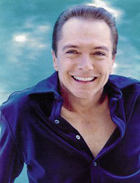
David Cassidy on the Web
The Never-Ending Story -
Las Vegas Extravaganza `EFX Alive' Tailored To The Talents Of Headliners
February 15, 2001
By Gary Dretzka
www.chicagotribune.com
LAS VEGAS -- At $45 million and counting, "EFX" is one of the most intricately staged and expensive theatrical productions ever mounted, but that doesn't mean it's too precious to change.
In fact, the MGM Grand extravaganza is about as elastic a show as one can imagine. Not only has it been made to fit the singular talents of a range of headliners -- Michael Crawford, David Cassidy, Tommy Tune and, now, Rick Springfield -- it also can accommodate new songs, new choreography, even a new title, "EFX Alive."
The one thing it won't ever do is travel.
Only Las Vegas is big enough to afford shows with budgets reaching such stratospheric levels as $100 million -- for "O" -- or bold enough to demand $75 to $100 a head for 90 minutes of entertainment.
Each new headliner brings something new to "EFX," and -- aside from the special effects-- no new generation of the show is exactly like its predecessors.
"This is a concept show, not a written show," said director Jerry Mitchell prior to one of the final rehearsals for the remounted show, which debuted on Jan. 30. "There's very little book to take you through the show. It's the star who takes you on a journey, and that journey remains the same.
"You have to visit Merlin, P.T. Barnum, Houdini and H.G. Wells. How you get to those four places and what you get out of it, however, can be adjusted according to the person taking you on the journey."
In the original version, launched six years ago, the actor leading the journey through a history of magic and illusion was the Effects Master, played by Michael Crawford, who was still basking in the success of "Phantom of the Opera." In later incarnations, the Effects Master -- voiced by James Earl Jones -- was a more nebulous presence, and the show played more off the impish charms of Cassidy and the tap choreography of Tune.
"David Mitchell's original ideas were brilliant, and I wanted to get back to them immediately, because the effects are as much the star of the show as the actors, and each show has been tailored to the star's talents," Mitchell said. "Rick's talents are rock 'n' roll and music, so we've been able to juice it up a bit and give it a little more contemporary feel."
Springfield's likeness on billboards and marquees above the Strip show him wearing a silk shirt, unbuttoned to his navel, and gripping one of the many guitars he plays during the show. The image is likely to pique the interest both of post-Baby Boomers and Springfield's legion of fans. Crawford, Cassidy and Tune, likewise, were able to draw from a deep reserve of loyalists, and, no one here anticipates seeing an unknown entertainer -- or one without a half-dozen fan Web sites, at least -- stepping in as Effects Master any time soon.
"They actually approached me when Michael Crawford was still the star," said Springfield before taking the stage recently. "I was involved in a television series at the time and was about to go out on tour for the `Karma' studio album. They approached me again when Tommy was the star, and it was the right time to do it.
"I liked the show the first time I saw it and thought it could be fun to do. David Cassidy picked it up a bit -- adding more energy, more rock 'n' roll to the show -- and then Tommy took it back in the direction of Broadway."
On this day, before joining the cast in rehearsal, Springfield recalled an ironic snippet of dialogue from one of his old movies.
"I said to my band, `If you keep playing like this, we'll all end up in Las Vegas,"' he says, with a broad smile. "But it's a different town now."
The same article also appeared in the Los Angeles Times on February 20, 2001
